Includes per night:
- 1x meal + 1x drink
- 1x overnight accommodation
- 1x breakfast in the restaurant
- 1x lunch pack
- 1x fill up coffee in your own thermos
Green Key approved
4.61826921182756 of 5 Stars
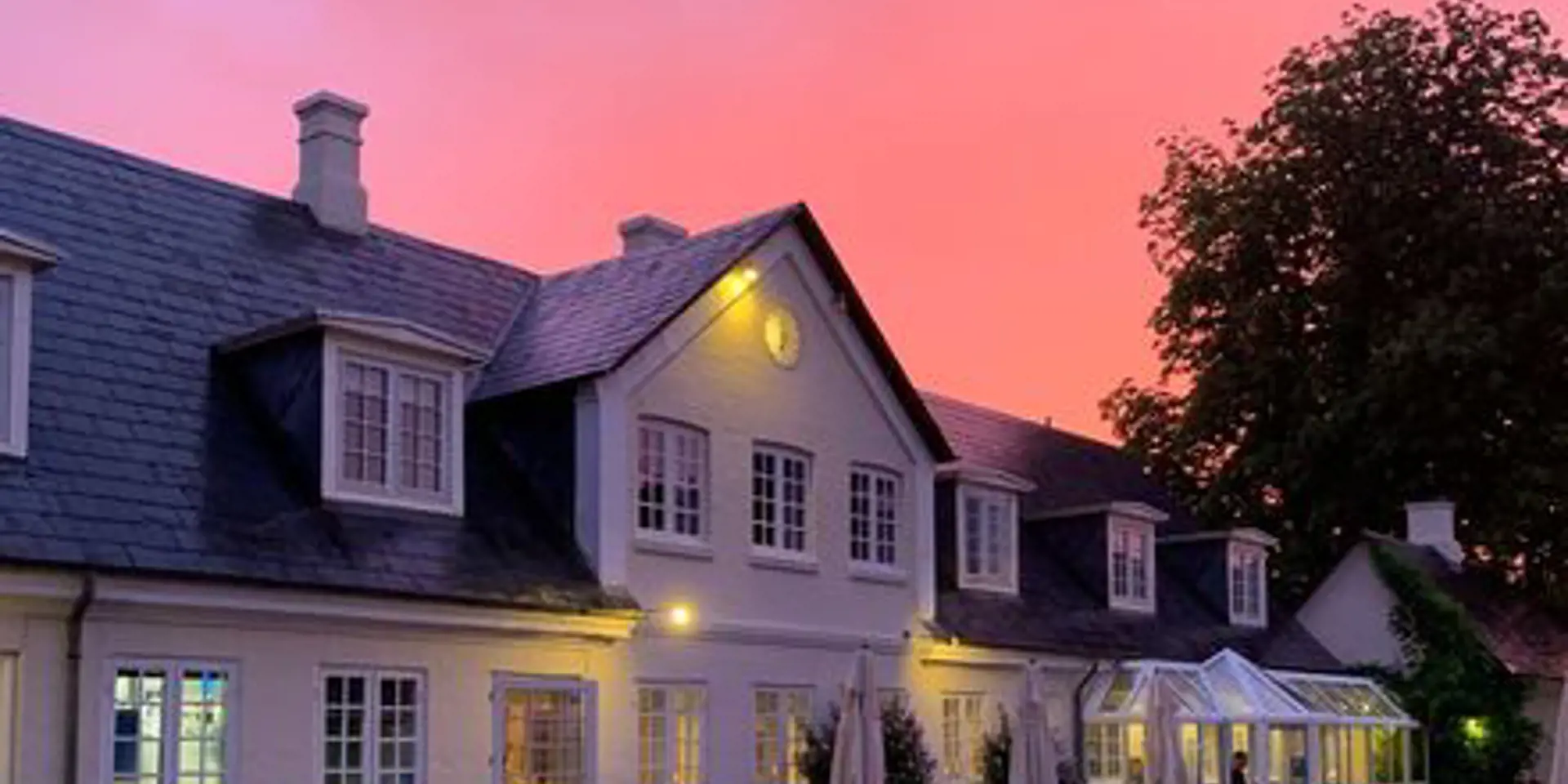
Includes per night:
Click the "See calendar and prices" button to choose dates and see the room selection.
See calendar and prices: Installer stayHotel Knudsens Gaard in Odense emphasizes personal service, high quality and a peaceful atmosphere. The uncontested attention is on the guests, who must be able to enjoy a relaxed stay in green surroundings. The hotel rooms have a homely feel and the restaurant delivers fantastic culinary experiences.
Hunderupgade 2, 5230 Odense
Show map

3 nights / 4 days - arrival 29.06.-10.08.
Includes per person per stay:
sailing trip
Arrival Friday or Saturday. Book min. 3 days before arrival
Includes per person:

Arrival Friday. Book min 3 days before arrival.
Includes per person:
Friday:
Saturday:
Sunday:

Includes per person per night:
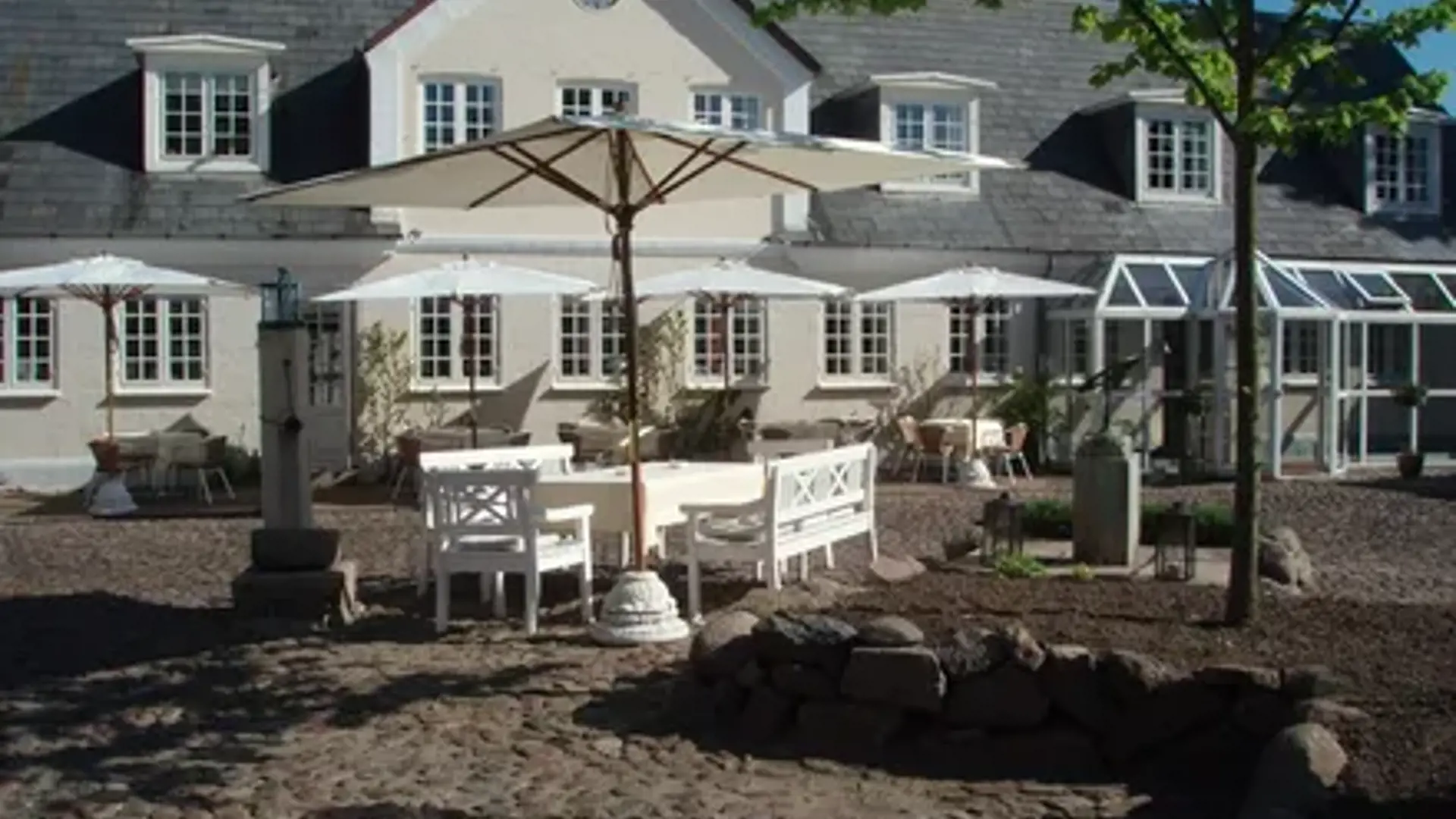
Min. 3 days / 2 nights. Must be booked no later than 3 days before arr. No arr. on Sundays
Includes per person per night:

Minimum 3 days/ 2 nights
Includes pr. person pr. day:

Not available on Sundays Jan - Jun & Sep - Dec. and bank holidays
Includes per person per day:

Oplevelsesgavekort med Produktid: 25011499
Inkluderer for 2 personer:

Oplevelsesgavekort med Produktid: 25021749
Inkluderer for 2 personer:
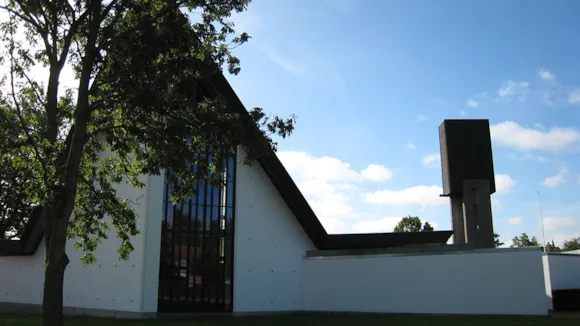
0.91 km
Munkebjerg Church was consecrated on the 5th of March 1961. Architecturally, it is a very modern church with low walls and a roof arched high above the hexagonal nave. The large glass mosaic, which acts as an altarpiece was consecrated on March the 27th 1983. It was created by the artist Knud Lollesgaard.

0.94 km
Would you like to explore a fully intact 450 m2 nuclear bunker from the 1950s?
This bunker has been restored to pristine condition and includes a majority of the original artefacts from the cold war era. The bunker further displays 3 exhibitions that each show a different side of the cold war. This includes the civil defence forces, the enemy from the east and the police force.
The bunker was built in 1953/54, it formerly housed Odense Municipality's command centre, and this was the location that the mayor and key personnel went to in a worst-case scenario during the Cold War. With space for about 30-35 key employees, it's own electricity, water and food supply, this bunker was prepared to be completely sealed off for an entire month!
Practical Information:
Guided tours are at 11 and 14 o'clock and are included in the admission fee.
The bunker is located under the youth hostel Kragsbjerggården, Kragsbjergvej 121, 5230 Odense M.

1.26 km
Viking Castle Nonnebakken
The Viking castle at Nonnebakken was one of at least five known ring castles, which King Harald Bluetooth built around 980. The others are Aggersborg at the Limfjord, Fyrkat at Hobro, Trelleborg at Slagelse, Borgring at Køge and probably Borgeby in Skåne.
The ring castles are to be seen as part of the unification of the Danish kingdom, partly by dominating the interior and partly by defending against external opponents. The now smoothed out castle mount, where the Odd Fellow Lodge is today, and some other tracks can be seen in the terrain, while other parts of the castle are well preserved, but hidden under the modern city.
The story has to be told on the spot
The archaeological excavations of recent years at the Viking castle Nonnebakken in Odense have uncovered new, groundbreaking knowledge. It is extremely interesting that the castle, contrary to the previous view, proves to be very well preserved - and that large parts of the Viking castle remain under the modern pavements.
What can you see today?
You can stand in the place where the ring castle was in its time. Here you can see two information boards that show where exactly the castle was and the extent of it. The castle itself is buried under the modern city, but you can still see the contours in the landscape.
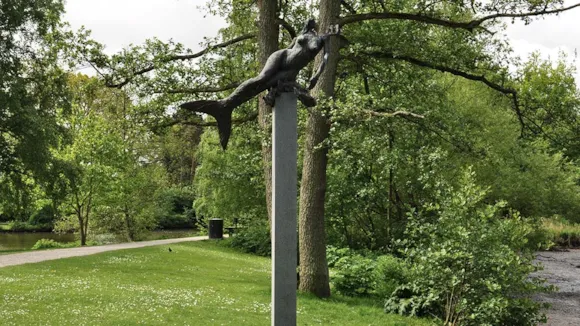
1.31 km
The mermaid is a mythical and magical creature, who lures people into their death with her song and her beautiful body.
This mermaid is placed on a 3-4-meter-high base so that we view her as from the deep of the ocean. Another distinctive feature of the sculpture is the abnormal head-to-body ratio, but this is a consequence of the water reflection which happens when you look up from the depths.
The sculpture is made in bronze and the base in granite and was revealed on June the 20th in 1998. The mermaid’s body is created to show sexual energy, which is emphasized by the slightly separated legs and distinct sex, that only gathers into a fin near the feet. The strength of its sexuality is highlighted as something raw, and a danger you put yourself in. The sculpture is, in its expression, almost an antithesis to the traditional understanding of the mermaid’s conventional innocence and beauty.
Hans Pauli Olsen (1957-) was born in the Faroe Islands. Many of his sculptures focus on human forms, often with a mystical, underlying note. They are expressive and naturalistic in their expressions. Many of his creations are created in clay before they are cast in bronze. This process allows the artist's creative process to be clearly visible in the final sculpture.
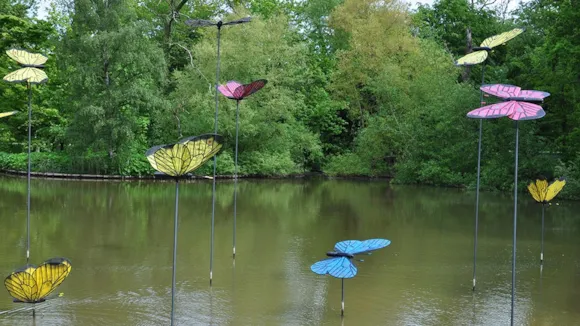
1.32 km
In Munke Mose you can find this fine sculpture/decoration of coloured butterflies floating above the water in the small lake. The inspiration for the sculpture comes from Hans Christian Andersen's fairy tale about Thumbelina sailing on a water lily leaf pulled by a butterfly after she has escaped from the toad. The colourful butterflies in Munke Mose are part of the fairy tale playground nearby.
Munke Mose is one of the most popular parks in Odense, and the fairy tale playground attracts many visitors daily. The large, colourful butterflies decorate the area around the small Thumbelina-inspired playground, where you can balance on big water lily leaves, slide down a large "cliff" or play by the stream.
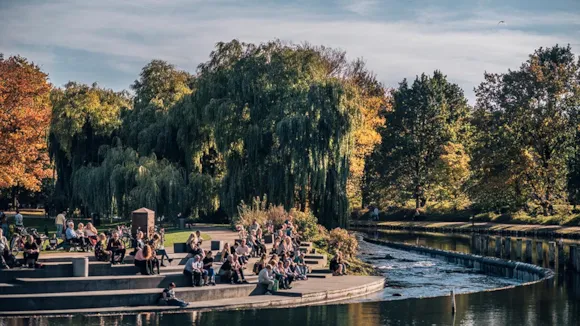
1.33 km
In 1881, Odense Municipality bought the area from Munke Mølle's factories because they wanted to keep it free of buildings. It was a low-lying bog and meadow area, which was partly used for grazing and haymaking. It was often flooded by the creek in the winter and used for skating.
In 1912, seed wholesaler Chr. Dæhnfeldt offered to pay 2/3 of the construction costs for a park and contacted the landscape architect Edv. Glæsl and asked him to draw up plans and estimates.
Today, Munke Mose is mainly used for spontaneous outdoor life, except for regular traditions such as May Day events and the last day of school.
The playground in Munke Mose for the smaller children is a local favourite. Here, some small natural elements such as birds, fish, water lily leaves and butterflies are made large and can be used as elements of play. It is also in this park that you will find Odense Aafart with tour boats, pedal boats and canoes, Nelle's Coffee, and Saabyes Stryg, a fish ladder built in 2008 for the enjoyment of guests in the park and the aquatic life in the river.
When you go for a walk in this park, you will also spot some of Odense's many, beautiful sculptures, like The Wild Swans, The Little Mermaid and The Seahorse.
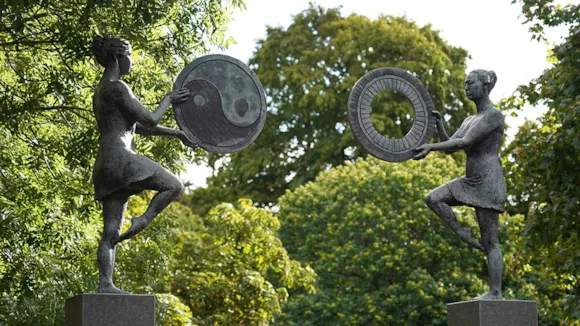
1.36 km
The Balance Arc - large sculpture in two parts
The sculpture itself is a gateway to a new world. It consists of two large Chinese granite columns with two women at the top.
The women are frozen in a balancing position, holding two wheels - two spinning wheels. One wheel is decorated with Hans Christian Andersen's paper cut-out "The Sun Head". The women are standing in a Tai Chi posture, which is a Chinese form of exercise closely related to the Ying-Yang figure and the philosophy of the eternal interplay of opposites. The name of the sculpture is precisely that: The Arc of Balance.
Sculptor Mette Agerbæk (1960 - 2011)
She trained as a graphic artist and sculptor at the Funen Art Academy (1982-86) and the Accademia di Belle Arti di Roma in Italy (1986-1987).
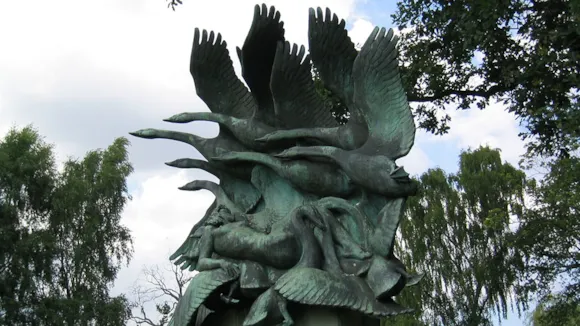
1.44 km
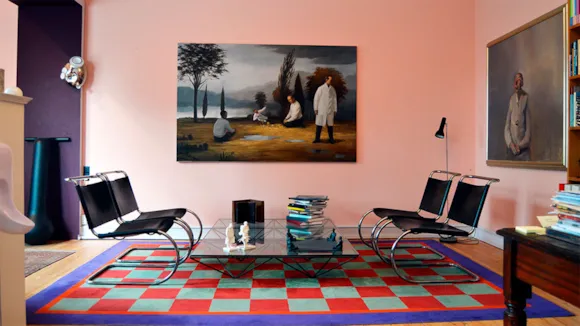
1.44 km
You'll have to ring the doorbell and climb a few steps before you're welcomed inside the gallery. Here you'll find a fully furnished apartment with artworks scattered all over the walls, shelves and windowsills. Nothing looks like a regular gallery here - no white walls and no artificial, uniform light from ceiling spotlights. The apartment is almost a work of art in itself. Each room is characterised by a different colour, which often interacts with the artwork. Regulars often notice how the whole apartment changes colour every time there is a new exhibition. For most artists, it's also a refreshing experience to see their work displayed in a more unconventional context - although some of the more experienced artists are already familiar with the concept from abroad.
If you want to be sure to get in, make an appointment in advance.
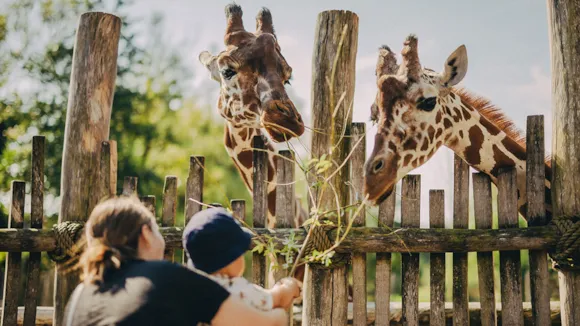
1.48 km
A zoo for the whole family
Odense ZOO is a zoological garden for the whole family – with lots of experiences for both little ones and adults. When you visit the zoo, you will surely get a nice and educational day filled with different experiences and lots of fun. While the younger ones play, the adults can enjoy a nice meal or a cup of coffee. Afterwards you can continue the tour around the garden which offers adventures for the whole family with many kinds of animals.
Experience the different animals
In Odense ZOO there are many different animals – maybe some you already know and maybe some more exotic ones. In the garden you can experience all kinds of animals like the Siberian tiger, exotic birds and the manatee below the water. When you tour the garden and see all the animals, you will experience a quite unique atmosphere and scenery which is a perfect fit according to which animals you come across – from the tropical South America to the Antarctic cold. You will also see the zebras and giraffes on the savannah and the turtles in The House of Darwin. There are many different animals in Odense ZOO, both the dangerous and wild and the smaller and softer animals.
Up close
There are lots of options when you want to get totally close when seeing the different kinds of animals. In Odense ZOO you can handfeed the big giraffes and during the summer holidays you get to visit the island of the lemurs where you will participate in feeding the perky animals. You can of course also watch as the zookeepers feed and train the animals in the zoo. as you can imagine, there are many opportunities for you to listen, see and learn when you visit the zoological garden with the very special and cozy atmosphere.
Go tree-top-walking
When visiting Odense ZOO, you have got an incredible opportunity to go to Bøgetoppen (top of the beeches). The trip in Bøgetoppen offers a walk in the canopy of the beautiful beech forest. In the canopy there are nine different platforms which are all connected by suspension bridges. Here you will get to experience a trip in a height of six to twelve meters above the ground! A very fun experience for the whole family when you get take the 250 meters long walk in the trees. A walk which offers both a beautiful view and maybe even some challenges. On the trip you will get to test your trivia knowledge in a digital quiz about Danish nature. In the quiz you might get some new information or maybe you get to beat your family in the fun game of who has the most knowledge about animals and insects in the canopy or the forest floor below.
And the best part of it all: Odense ZOO is open all year round – so bring your family and get an experience of a lifetime!
Green Attraction-certified experience
Green Attraction is a Danish environmental certification awarded to attractions that actively prioritize sustainability and environmental responsibility. To receive the certification, an attraction must meet a range of requirements in areas such as energy consumption, waste sorting, sustainable purchasing, and communicating green initiatives to visitors.

1.5 km
You will find the fairytale garden by Odense Å, just behind Odense Cathedral and Odense City Hall. Via a nice wooden bridge, you can cross the river over to the rotunda, a small circular island in the garden. Depending on the season, the beds here are bursting with spring bulbs, dahlias and perennials, and you can sit on the benches and enjoy the view. The cosy wooden staircase along the water invites you to sit and watch the water and the ducks.
In 1949, the H.C. Andersen statue, created by Louis Hasselris, was placed in the garden. Close by in the river, Erik Heide's sculpture The Paper Boat from 1985 sails along, and there are several other sculptures around the park.
The pergola on the rotunda, the bridges in the garden and the Chinese wall have been designed and executed in quality materials, worthy of a town hall garden. The original pergola showcased a beautiful pattern of diamond-shaped beds.
The garden was laid out in 1876 by the Reading Association, and initially, it was closed to ordinary visitors. The reading association was a library for wealthy citizens, and only people with access cards could visit. In 1942, the Reading Association transferred the garden to Odense Municipality, and a completely new park emerged. Behind the project were the garden architects C. Th. Sørensen and P. Wad, in collaboration with architect B. Helweg-Møller, who was the architect of the town hall.
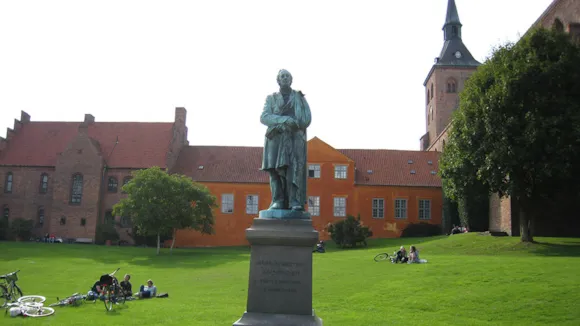
1.58 km
This bronce statue was revealed on June the 19th in 1888 in the Kings Garden. In 1905 it was moved to Graabroedre Plads and in 1949 it was moved to it's current position in the Fairytale Garden.
The artist, Louis Hasselriis, lived almost uninterrupted in Rome from 1869 until his death. From there he entered the competition to create a monument to the fairy tale poet Andersen in Copenhagen. He didn't win the competition, but Hasselriis kept working and fought to have his work exhibited in Odense and in 1888 the people of Odense had saved enough money to buy it. The sculpture never looked exactly as the artist had envisioned it, though.
If you are interested in Hans Christian Andersen we recommend you visit his museum and Hans Christian Andersen’s childhood home as well.